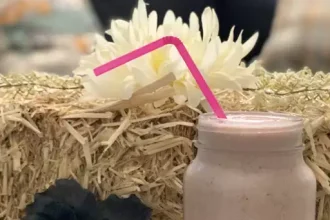Each has its advantages, but in the end, both can be part of a healthy diet.
Not eating as much fruit as you should? You’re not alone. Although the 2020-2025 Dietary Guidelines for Americans recommend that most people eat two cups daily, only 12.3% of individuals are meeting that goal, according to the Centers for Disease Control and Prevention.
There are numerous reasons to ensure you’re eating enough fruit, with fibre being one of the biggies. “All fruits have naturally occurring fiber, which is beneficial for gut health and, of course, reducing the risk of heart disease, diabetes and certain cancers,” says Kara Burnstine, M.S., RD, a nutrition educator at Pritikin Longevity Center in Miami. Fruits also contain various disease-fighting antioxidants, which is why the more variety of fruit that you eat, the better.
Eating fruit—in conjunction with veggies—may even increase your longevity. Consider this 2021 study from Circulation, which found that eating two servings of fruit as well as three servings of vegetables lowered the risk of death.
Of course, though, fruit comes in two main forms, namely fresh and dried, so which is healthier? The answer might seem obvious at first, but a deeper dive reveals a not-so-cut-and-dried answer.
The Advantages of Fresh Fruit
When evaluating the benefits of fresh fruit over dried fruit, you have to start with the obvious, namely the water content. While dried fruit lacks water, most fresh fruit is at least 80% water. That then skews the calories. “Because the water is removed, dried fruits are significantly higher in calories than fresh fruits,” Burnstine says, adding that fresh fruits are also more hydrating as a result. Compare, for instance, a cup of grapes has about 62 calories while a cup of raisins has over 434 calories, possibly limiting any weight loss goals you might have.
Water content also affects sugar, and as you might guess, a lower amount of water means higher amounts of sugar and vice versa. In other words, fresh fruits have less sugar than dried fruits. Take that same cup of grapes and raisins, for instance. While you’ll consume only about 15 grams of sugar if you eat the grapes, the raisins will add 116 grams of sugar to your day. If you have blood sugar issues, dried fruits will cause a quick rise if you eat too much at once, Burnstine says.
Here’s another reason to love the water content of fresh fruits: It’ll make you fuller. “Being exponentially greater in water content and overall volume means that fresh fruit is more filling, as a serving of fresh fruit is typically much larger than dried fruit,” says Jenna Volpe, RDN, LD, a functional medicine dietitian and holistic nutritionist in Austin, Texas. This means you’ll get a relatively similar amount of calories and sugar from a cup of fresh fruit as you would from only a few tablespoons of its dried counterpart.
Fresh fruits also contain more live enzymes, which may aid in the digestive process, and water-soluble vitamins like vitamin C and some types of B vitamins, Volpe says.
The Advantages of Dried Fruit
So with all the advantages of fresh fruit, you might wonder if dried fruit has a shot at redeeming itself. Surprisingly, the answer is yes.
Start with the obvious, namely the convenience factor. “Dried fruit is generally more portable, less perishable, and more practical to bring on the go compared to most types of fresh fruit,” Volpe says.
Dried fruit may even hold some nutritional advantages. “Ounce per ounce, there’s more fibre and an antioxidant called phenols in dried fruit over fresh, primarily because dried fruits are much more concentrated,” Burnstine says. One study from the Journal of the Academy of Nutrition and Dietetics published in 2021 found that dried fruit eating was associated with higher diet quality, fibre, potassium and polyunsaturated fat intake when people ate dried fruit versus days when they skipped dried fruits.
Certain types of dried fruits, like prunes, are also better at keeping you regular versus their fresh counterparts, Volpe says. Prunes and plums are classic examples—prunes more effective at encouraging regular bowel movements than plums.
So, Which Is Healthier?
Debating whether fresh or dried fruit is healthier than the other is somewhat of a moot point, given that each has pros and cons, and both can count toward your daily intake. Yet if she had to choose, Volpe would give fresh fruit the edge for its nutrient content; plus, “fresh fruit is less likely to contain hidden sources of added sugar,” Volpe says.
Dried fruits, after all, can contain added sugars, like cane sugar, corn syrup or high fructose corn syrup. If you’re trying to navigate blood sugar issues, hormonal imbalances or gut dysbiosis where you have an imbalance of healthy versus unhealthy gut microbes, dried fruits may not be the better option, Volpe says.
Another issue is that dried fruits are often preserved in sunflower, canola or soybean oils, which may be a negative for some individuals. “Most Americans are already overconsuming omega-6 fats from seed oils,” Volpe says, adding that many people have a sensitivity or allergy to soybeans.
And while there’s always the concern that conventional fresh fruit may contain pesticides, dried fruit may be even more problematic. According to a 2022 report by the Environmental Working Group, pesticides were detected in half of the non-organic dried fruits that the group tested. In fact, every year, the EWG publishes its Dirty Dozen list, naming the 12 types of produce with the highest pesticide load. And although raisins aren’t analyzed for this list because the EWG considers them processed food, it did look at raisins in 2020. Its conclusion? If raisins were a Dirty Dozen contender, they would rank as the dirtiest produce.
The Bottom Line
Though it might seem like it, this doesn’t mean you shouldn’t eat dried fruit. Burnstine, in fact, recommends consuming fresh and dried as long as you keep your portions of dried fruit in check. A serving of dried fruit is about a quarter of a cup. Still, because it’s easy to overconsume when eaten alone, Burnstine recommends using dried fruit as an accessory in salads, baked goods, oatmeal and smoothies.
Check labels when buying dried fruit to ensure it doesn’t contain added sugar. The EWG recommends choosing organic dried fruits whenever possible to avoid or, at the very least, minimize your pesticide exposure.
Meanwhile, aim for about two cups of fresh fruit every day, Burnstine adds. The best part about this prescription? Fresh fruit is nature’s candy, which means you’ll satisfy that sweet tooth without added sugars.
















